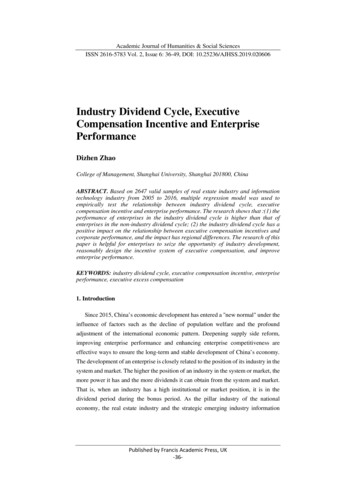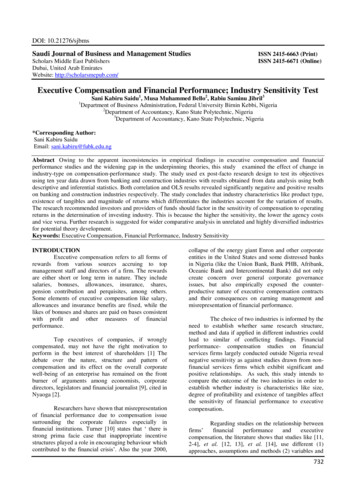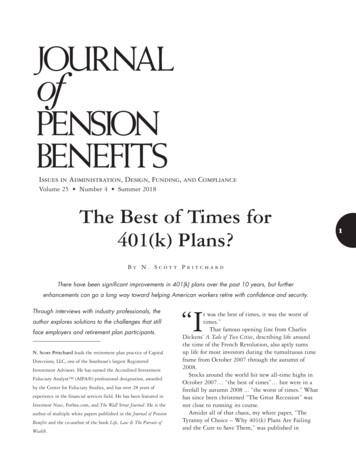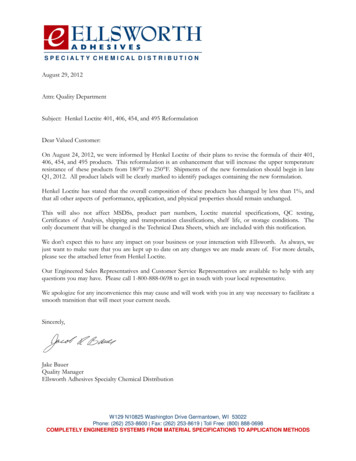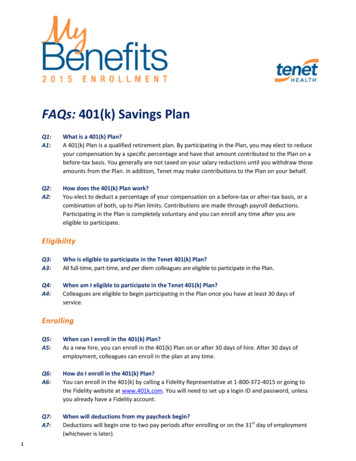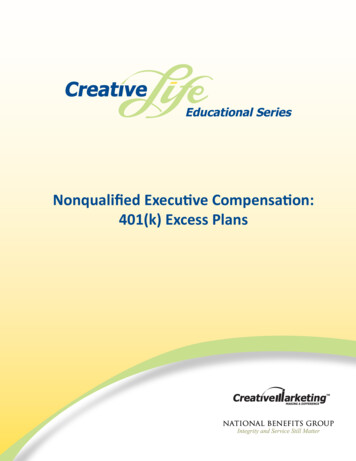
Transcription
Educational SeriesNonqualified Executive Compensation:401(k) Excess Plans
Page 1Educational SeriesNonqualified Executive Compensation: 401(k) Excess PlansAbout the Plan, How It Works, Considerations and How to FundWHAT IS A 401(K) EXCESS PLAN?A 401(k) excess plan is an employer–sponsored nonqualified deferred compensation plan designed to attract andretain key executives. Much like an employer’s qualified 401(k) plan, the excess plan allows the executive to defera portion of his or her salary on a pre-tax basis, and the employer may choose to match the salary deferral. Unlikea qualified 401(k) plan, the excess plan is offered only to select key employees. At an executive’s retirement oranother specified date, the employer will begin payment of the executive’s account balance, which may be taxdeductible for the employer.WHO MAY BE INTERESTED IN A 401(K) EXCESS PLAN?EXECUTIVES Wanting to maximize their qualified plan contributionsLooking for supplemental retirement incomeReceiving funds from their qualified 401(k) plan due to top hat testingPreferring to defer paying taxes on income they don’t currently needBUSINESSES Looking to provide substantial benefits to key executives Needing an executive retention strategy That are top heavyHOW DOES A 401(K) EXCESS PLAN WORK? An executive enters into an agreement with the employer to defer an amount of compensation to a futuredate, thereby deferring current income taxes as well, in return for retirement. The employer has the optionof making a matching contribution to the executive’s account balance. This is similar in design to the qualified401(k) plan that is often already provided by employers. The employer will create an accounting entry in its financial statements that represents the executive’saccount balance. The executive’s account is an unsecured promise by the employer to pay the executive afuture benefit.FOR AGENT USE ONLY. NOT FOR USE WITH THE GENERAL PUBLIC. 12377 - 2012/7/12 2012 Creative Marketing International Corp.
Page 2Educational SeriesAGREEMENTESTABLISHED Many employers choose to purchase a life insurance policy on theexecutive’s life, naming itself owner and beneficiary of the policy. Thepolicy is a bookable asset to the employer and may offer tax deferredgrowth, as well as death benefit protection. Please note that the lifeinsurance policy is not the plan; it is merely an informal funding vehicleutilized by the employer to accumulate the funds necessary to pay thebenefits due under the plan. The executive must give written consentto the life insurance coverage. The employer will typically use theemployee’s deferrals to pay the premiums of the insurance policy. At the executive’s retirement, the employer pays the executive duecompensation. If life insurance was used, payments can be made viatax-free distributions of the cash value accumulated within the lifeinsurance policy. The payments from the plan will be taxable incomefor the executive and tax deductible for the employer. In the event of the executive’s death, the employer will receive a taxfree life insurance death benefit. If the employer has not completed thepayments due to the executive under the terms of the agreement, theemployer may use the death benefit to pay the executive’s heirs theremainder due any excess to be used as the employer wishes.WHY CONSIDER A 401(K) EXCESS PLAN?between employerand executiveDEFER EXECUTIVECOMPENSTIONEMPLOYERACCOUNTING ENTRYbookable assetEMPLOYER CREATESFUNDING VEHICLEexecutive life insurancepolicy with employer asbeneficiaryTAX DEFERREDPOLICY GROWTHaccumulates to fund the401(k) excess planAVOID THE FOLLOWING GOVERNMENT BENEFIT RESTRICTIONSWITH A “NONQUALIFIED” PLAN Compensation cap for qualified plan contributions and benefitsCode Section 415 contribution and benefit limitsElective deferral limitsMatching contribution limitsAfter-tax contribution limitsReporting requirementsNondiscrimination requirementsFOR AGENT USE ONLY. NOT FOR USE WITH THE GENERAL PUBLIC. 12377 - 2012/7/12 DEATH OFEXECUTIVEpaid by employerin terms of theagreement toexecutive’s heirs(funded througha life insurancepolicy and taxdeductible toemployer)EXECUTIVERETIREMENTcompensationpaid to executiveby employer(funded througha life insurancepolicy and taxdeductible toemployer) 2012 Creative Marketing International Corp.
Page 3Educational SeriesOFFER IMPROVED EMPLOYEE BENEFITS Efficient way for employees to save for retirement after qualified plan opportunities are exhausted Excluded compensation (bonuses, incentive cash payments) for qualified pension plans may be part ofnonqualified plans May be used to facilitate early retirementHOW CAN LIFE INSURANCE FUND A 401(K) EXCESS PLAN? Employer pays premiums with employee deferrals Employer is the owner and beneficiary of the insurance policies Funds accumulate tax-deferred in life insurance Tax-free distributions from life insurance cash values may be used to pay benefits Employer receives insurance benefit tax free at employee’s death Employer recovers all outlays:Premium paymentsRetirement benefitsCorporate cost of moneyPlan results are hypothetical only. Actual results will vary due to changes in contributions and withdrawals, incometax brackets, and investment performance.This report makes reference to concepts which have significant legal, accounting and tax implications. Our commentsare intended to convey our general understanding of the applicable principles, but are not intended as legal,accounting or tax advice. We recommend that you consult your legal, accounting and tax advisors for applicationof these concepts as they relate to your specific factual situation. Securities offered through ProEquities, Inc. Aregistered broker-dealer, member FINRA & SIPC. National Benefits Group is independent of ProEquities, Inc. 5280-96FOR AGENT USE ONLY. NOT FOR USE WITH THE GENERAL PUBLIC. 12377 - 2012/7/12 2012 Creative Marketing International Corp.
Page 1Educational SeriesNonqualified Executive Compensation: 401(k) Excess PlansFrequently Asked QuestionsMINIMUM EMPLOYEE REQUIREMENTS FAQsAre there a minimum number of employee participants required for a 401(k) excess plan?No. “Nonqualified” plans are not subject to the participation requirements typically associated with traditionalqualified retirement plans. No minimum number of employees is required, and the employer has complete discretionin determining eligibility for the plan.Are there a maximum number of employees required for a 401(k) excess plan?No. In fact, there are corporations with this type of plan in place for hundreds of employees. However, deferrals areusually limited to the top layers of an employee’s compensation, those amounts which are subject to top marginalincome tax rates.INCOME LIMITATIONS & EMPLOYEE ELECTIONS FAQsIs there any limit on the amount of income employees may defer?No. Employees may, theoretically, defer up to 100% of total compensation. The only limits are those imposed by theemployer establishing the plan.When do employees have to decide how much to defer?Employees need to complete their deferral elections prior to the end of each calendar, with two exceptions. The firstexception is the first plan year, during which employees may make deferral elections within the first 30 days. Thesecond exception is with performance-based bonuses, for which employees may make elections six months beforethe bonus can be determined.REPORTING FAQsAre there complex reporting and disclosure requirements for 401(k) excess plans?Not necessarily. The Department of Labor requires a letter with plan identification information when the plan isestablished. NBG will provide a sample letter to use. Public companies may have additional proxy disclosure requirementsfor named officers.FOR AGENT USE ONLY. NOT FOR USE WITH THE GENERAL PUBLIC. 12378 - 2012/7/12 2012 Creative Marketing International Corp.
Page 2Educational SeriesTRUSTS AND 401(k) EXCESS PLANS FAQsCan an employer use a trust to help secure its promise to pay deferred compensation benefits inthe future?Yes. The employer can establish a trust and deposit employee deferrals in accordance with the provisions of the trust.Funds will be held by the trustee for the benefit of plan participants.How are funds placed in the trust treated by the employer for tax purposes?Amounts contributed to the trust are not deductible by the employer until they are subject to taxation for the employee.Typically this occurs when retirement payments begin. The trust is generally structured as a “grantor” trust so thatall taxable income and/or tax deductions generated by the trust are attributed to the employer. Any interest orinvestment income on trust assets is taxable to the corporation. If life insurance is used, the tax deferral associatedwith life insurance generally eliminates corporate taxes on trust income.How are employees taxed on income they defer and on the interest or investment income accruingto the trust?All employee taxes are deferred until the employee is in “constructive receipt” of the funds, either because paymentshave been made directly to the employee, or because the money has been available to the employee without restriction.EMPLOYEE FAQsAre employee deferral account balances subject to the claims of general creditors?Yes. In order to obtain favorable tax treatment, plan assets are subject to the claims of general creditors of the employer.Can employees assign their benefits under the plan?No, they may not.Are employees required to make irrevocable decisions about the timing of retirement and retirementpayments from the plan, or is there flexibility?There is some flexibility for employees in determining the timing of payments from the plan. The employee makesan initial election at plan inception and is generally allowed to postpone distributions as long as the new electionprecedes the calendar year of the originally scheduled distribution. Payments may be accelerated only in case ofdeath, termination of employment, change of company ownership or other limited circumstance outlined in theplan documents.Plan results are hypothetical only. Actual results will vary due to changes in contributions and withdrawals, incometax brackets, and investment performance.This report makes reference to concepts which have significant legal, accounting and tax implications. Our commentsare intended to convey our general understanding of the applicable principles, but are not intended as legal,accounting or tax advice. We recommend that you consult your legal, accounting and tax advisors for applicationof these concepts as they relate to your specific factual situation. Securities offered through ProEquities, Inc. Aregistered broker-dealer, member FINRA & SIPC. National Benefits Group is independent of ProEquities, Inc. 5280-96FOR AGENT USE ONLY. NOT FOR USE WITH THE GENERAL PUBLIC. 12378 - 2012/7/12 2012 Creative Marketing International Corp.
Page 1Educational SeriesNonqualified Executive Compensation: 401(k) Excess PlansCase Study: Comparison of Salary Paid and DeferredFor the most common tax situation, a deferral strategy produces better financial results than taking receipt of currentcompensation, paying taxes and developing an outside investment program. The following example illustrates theeconomics for a 45 year-old who defers 10,000 per year for five years against receipt of income. In both scenarios,withdrawals are made for 15 years beginning at retirement.CASE STUDY: 45 year-old, defers 10,000 annually for five yearsDeferred salaryIncome taxes @ 40%Funds available for investmentPre-tax returnAfter-tax return*Accumulation at age 65Annual benefitAnnual income tax @ 40%Annual receivedPayout yearsTOTAL AFTER-TAX BENEFITReceipt of SalaryDeferral of Salary 401(k) Excess Plan 50,000( 20,000) 30,0008.0%6.4% 91,990 9,136 0 9,136x15 years 50,000( 0) 50,0008.0%8.0% 200,986 21,742( 8,697) 13,045x15 years 137,040 195,675*Illustrated 20% tax rate for taxable investment accountsRESULTS: Deferral of salary option increases after-tax benefit by 58,635 in 15 yearsADDITIONAL CONSIDERATIONSEXECUTIVE The distributions from the 401(k) excess plan will be considered taxable income. If the 401(k) excess plan provides a survivor benefit, the executive’s excess plan account balance will be includedin his or her taxable estate.BUSINESS A 401(k) excess plan is subject to the requirements of IRC Section 409A. Failure to meet the requirements ofIRC Section 409 will result in substantial tax penalties for the executive/participant.Plan results are hypothetical only. Actual results will vary due to changes in contributions and withdrawals, incometax brackets, and investment performance.This report makes reference to concepts which have significant legal, accounting and tax implications. Our commentsare intended to convey our general understanding of the applicable principles, but are not intended as legal,accounting or tax advice. We recommend that you consult your legal, accounting and tax advisors for applicationof these concepts as they relate to your specific factual situation. Securities offered through ProEquities, Inc. Aregistered broker-dealer, member FINRA & SIPC. National Benefits Group is independent of ProEquities, Inc. 5280-96FOR AGENT USE ONLY. NOT FOR USE WITH THE GENERAL PUBLIC. 12371 - 2012/7/10 2012 Creative Marketing International Corp.
retain key executives. Much like an employer’s qualified 401(k) plan, the excess plan allows the executive to defer a portion of his or her salary on a pre-tax basis, and the employer may choose to match the salary deferral. Unlike a qualified 401(k) plan, the excess plan is offered only
